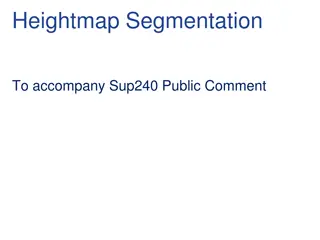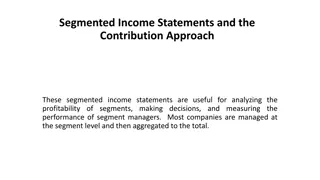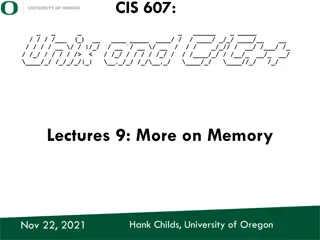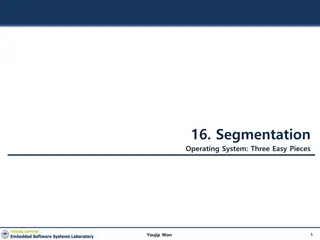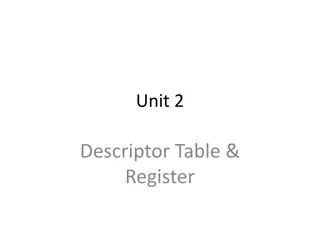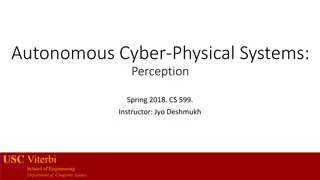Memory Segmentation and Segment Descriptors in System Engineering
How memory segmentation works in system engineering, from 8086 to 80386 processors. Dive deep into segment descriptors, defining segments for different purposes like code, data, and stack. Learn about creating segment descriptors, determining base address and size, privilege levels, and more.
Download Presentation

Please find below an Image/Link to download the presentation.
The content on the website is provided AS IS for your information and personal use only. It may not be sold, licensed, or shared on other websites without obtaining consent from the author.If you encounter any issues during the download, it is possible that the publisher has removed the file from their server.
You are allowed to download the files provided on this website for personal or commercial use, subject to the condition that they are used lawfully. All files are the property of their respective owners.
The content on the website is provided AS IS for your information and personal use only. It may not be sold, licensed, or shared on other websites without obtaining consent from the author.
E N D
Presentation Transcript
Information Security - 2 Topic: Architectural Aid to Secure Systems Engineering V. Kamakoti RISE LAB, Department of Computer Science and Engineering IIT Madras SESSION 15: MEMORY SEGMENTATION DEEP DIVE 1 (SEGMENT DESCRIPTORS)
Memory Segmentation Segment Descriptors 80886 to 80386+ In 8086, the program is not expected to generate a non- existent memory address. If it does, then the processor shall try to access the same and read bogus data, or crash In 80386+ (and above) the segment attributes (base, limit, privilege etc) are programmable and no matter how privileged the code may be, it cannot access an area of memory unless that area is described to it.
Insight into 80386+ segments Segments are Areas of memory Defined by the programmer Used for different purposes, such as code, data and stack Segments are not All the same size Necessarily paragraph aligned Limited to 64KB
Segment Descriptors Describes a segment using 64-bits (0-63) Must be created for every segment Is created by the programmer Determines a segment s base address (32-bits) (Bits 16-39, 56-63) Determines a segment s size (20-bits) (Bits 0- 15, 48-51)
Segment Descriptors (Contd) Defines whether a segment is a system segment (=0) or non-system (=1) (code, data or stack) segment (System bit) (Bit 44) Determines a segment s use/type (3-bits) (Bits 41-43) after the above classification Determines a segment s privilege level (2 bits) (Bits 45-46) DPL (Descriptor Privilege Level) Bits
Segment Descriptor (Contd) Accessed (A)-bit: Bit 40, automatically set and not cleared by the processor when a memory reference is made to the segment described by this descriptor. Present (P)-bit: Bit 47, indicates whether the segment described by this descriptor is currently available in physical memory or not. Bits 40-47 of the descriptor is called the Access Right Byte of the descriptor. User (U)-bit and X bit: Bit 52 (U-bit) not used and Bit 53 (X-bit) reserved by Intel
Segment Descriptor (Contd) Default size (D)-bit: Bit 54, when this bit is cleared, operands contained within this segment are assumed to be 16 bits in size. When it is set, operands are assumed to be 32-bits. Granularity (G)-bit: Bit 55, when this bit is cleared the 20-bit limit field is assumed to be measured in units of 1byte. If it is set, the limit field is in units of 4096 bytes.
Types of non-system segment descriptors System bit S = 1 000 Data, Read only 001 Data, Read/Write 010 Stack (expand down), Read only 011 Stack (expand down), Read/Write 100 Code, Execute only 101 Code, Execute/Read 110 Conforming Code, Execute only 111 - Conforming Code, Execute/Read
D-bit for different descriptors Code segment D = 0 then 16-bit 80286 code D = 1 then 32-bit 80386+ code Stack Segment D = 0 then stack operations are 16-bit wide, SP is used as a stack pointer, maximum stack size is FFFF (64 KB) D = 1 then stack operations are 32-bit wide, ESP is used as a stack pointer, maximum stack size is FFFFFFFF (4 GB)
G-bit for descriptors G = 0 then a limit field in descriptor of value p indicates we can access p-1 bytes from base G = 1 then a limit field in descriptor of value p indicates we can access (p * 4096) - 1 bytes from base
Stack/expand down segments All offsets must be greater than limit. In stack descriptor, D and G bits are to be the same, else contradiction. Addressa ble area FFFF FFFF Limit Limit Addressa ble area Non-stack Base Stack/expand-down Base
End of Session-15 Thank You




